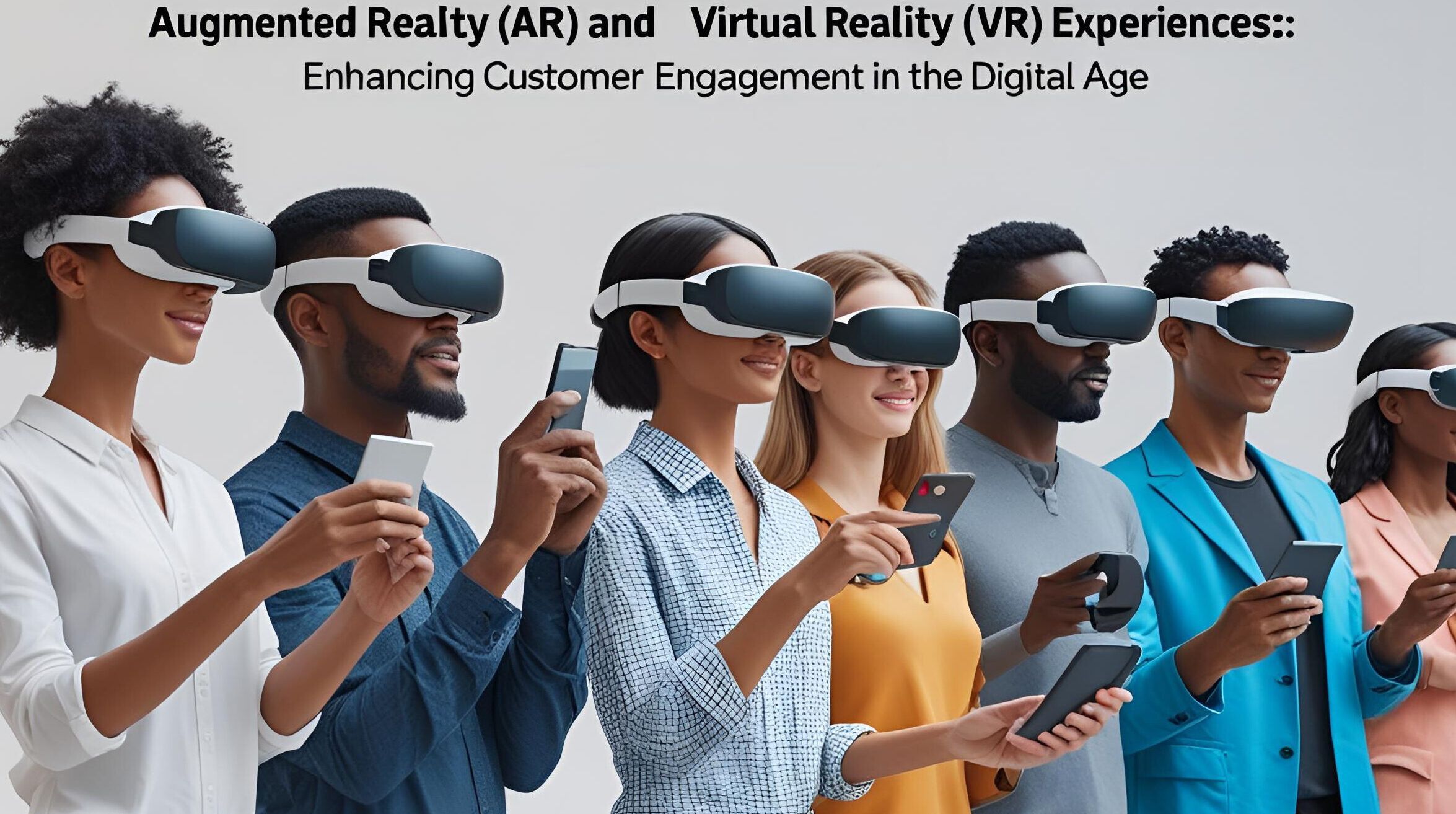Augmented Reality (AR) and Virtual Reality (VR) Experiences: Enhancing Customer Engagement in the Digital Age
Introduction:
In today’s competitive digital landscape, brands are constantly seeking innovative ways to engage their audiences. Augmented Reality (AR) and Virtual Reality (VR) have emerged as transformative technologies, offering interactive and immersive experiences that blend digital elements with real-world environments. As a result, they unlock exciting new possibilities for customer engagement.
What Are AR and VR?
- Augmented Reality (AR): AR enhances the physical world by overlaying digital content—such as text, images, or animations—onto real-life environments. It typically operates through devices like smartphones, tablets, or AR glasses.
- Virtual Reality (VR): VR immerses users in entirely digital environments. Using headsets and hand controllers, users can explore simulated spaces that fully replace their physical surroundings.
Although both are immersive, AR supplements reality, while VR replaces it entirely.
Key Differences Between AR and VR
| Feature | Augmented Reality (AR) | Virtual Reality (VR) |
| Immersion Level | Enhances the real world | Fully immerses users in digital environments |
| Device Requirement | Smartphones, tablets, AR glasses | VR headsets and controllers |
| Common Uses | Try-ons, navigation, product demos | Gaming, training, virtual tours |
Benefits of AR and VR in Marketing
Boosted Engagement
These technologies turn users into active participants. Interactive visuals, audio, and gestures result in deeper, more meaningful engagement.
Stronger Brand Awareness
AR/VR campaigns are distinctive and easily shareable. Their novelty helps generate buzz and long-term brand recall.
Enhanced Customer Experience
Immersive and personalized encounters improve customer satisfaction, making users feel more informed and connected.
Higher Conversion Rates
When customers can clearly visualize products or engage with services virtually, they are more likely to make confident, informed purchases.

Real-World Applications of AR and VR
- Product Demonstrations:
Allow customers to explore 3D models of products before buying. - Virtual Try-Ons:
AR enables users to “wear” items like clothing, glasses, or makeup, reducing the likelihood of returns. - Immersive Storytelling:
Brands can develop virtual environments where customers experience narratives rather than just reading them. - Training & Education:
VR provides safe, controlled learning environments, ideal for industries like healthcare, aviation, and customer service.
Best Practices for Implementing AR and VR
Set Clear Objectives
Define specific goals—whether it’s brand awareness, education, conversions, or engagement.
Choose the Right Tools
Use platforms and devices that align with your target audience’s preferences and digital behavior.
Create Valuable Content
Ensure content is not just visually appealing but also useful and relevant to the user’s needs.
Track and Improve
Leverage analytics to measure performance. Refine the experience based on user behavior and feedback.
Challenges to Consider
- High Development Costs:
Creating AR/VR experiences can require substantial investment in technology and skilled talent. - Technical Barriers:
Hardware limitations and compatibility issues may restrict user access and satisfaction. - User Resistance:
Some users may be slow to adopt new technologies or feel intimidated by unfamiliar devices. - Content Demands:
Producing quality 3D models, animations, and scripts demands time, effort, and resources.
Why AR and VR Matter for Engagement
- Creating Immersive Experiences
AR and VR go beyond showcasing a product—they allow users to experience it firsthand. This interaction fosters stronger memories and emotional bonds.
- Building Emotional Connections
From virtual home tours to 360° destination previews, these technologies evoke emotions. Emotional engagement often leads to customer loyalty and higher sales.
- Delivering Personalized Solutions
Tools like AR furniture visualizers or beauty try-on apps help users make better decisions. This level of customization reduces doubt and adds real value.
The Future of AR and VR in Marketing
As 5G, wearable tech, and AI become more mainstream, AR and VR will continue to evolve. Upcoming trends include:
- Mixed Reality (MR):
A blend of AR and VR that enables real-time interaction between physical and digital elements. - Spatial Computing:
Allows users to interact with 3D digital environments using motion, voice, and spatial recognition. - Metaverse Marketing:
Brands are beginning to explore digital worlds where they can host virtual stores, events, or customer service hubs.
The future is immersive, and early adopters will have a significant competitive advantage.
Conclusion
Augmented Reality and Virtual Reality are revolutionizing customer engagement. They go beyond passive content delivery, offering dynamic, customized, and memorable experiences. Whether used for entertainment, education, or ecommerce, these technologies are vital tools in the modern marketer’s toolkit. By integrating AR and VR, brands can establish deeper connections and foster lasting customer relationships that drive growth.
Key Takeaways
- Immersive Experiences: AR and VR provide engaging, interactive ways to captivate users.
- Improved Outcomes: These tools enhance brand awareness, engagement, and conversion rates.
- Versatile Applications: Use cases span training, storytelling, virtual shopping, and more.
- Future-Ready: Mixed reality and the metaverse signal vast upcoming opportunities.
FAQs
Q1: What’s the main difference between AR and VR?
A: AR overlays digital elements on the real world, while VR places users in a fully digital environment.
Q2: How do AR and VR help brands?
A: They enhance engagement, personalize user experiences, and increase conversions through interactive content.
Q3: What industries benefit most from AR/VR?
A: Retail, real estate, education, healthcare, and tourism are leading adopters.
Q4: Are AR and VR expensive to implement?
A: While initial costs may be high, the return on investment from increased engagement and sales often makes it worthwhile.
Q5: What’s next for AR and VR?
A: Technologies like 5G, spatial computing, and the metaverse will expand accessibility and capabilities significantly.

1 thought on “Differences Between AR and VR”